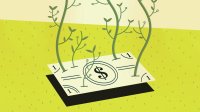A Financial Literacy Project Focused on the Future
A financial literacy project helps high school students plan for the lives they hope to lead through discussions of values and budgets.
Your content has been saved!
Go to My Saved Content.All of us can probably remember being asked as children, “What do you want to be when you grow up?” Even at a young age, I always knew I wanted to be a teacher, but I never stopped to think about how that would impact my adult budget or lifestyle, nor did I stop to imagine how the world might change between when I was in elementary school and when I entered the workforce in 2017.
A new project I developed helps high school students tackle that question by grounding it in financial literacy and “futures thinking”—thinking about possible futures. This project, which I call Gen Z Money, gives students the chance to think carefully about the life they hope to lead, while also opening up authentic opportunities for meaningful conversations around personal values, finances, budgeting, and future college and career decision-making. It helps students better understand that the path toward success isn’t always linear, a lesson that I am still learning.
Although I use this project in an after-school setting with students who have interests in business, Gen Z Money can easily be adapted for other classes such as English or economics.
What Is Futures Thinking?
In a recent Medium article, Laura McBain and Lisa Kay Solomon argue that we have an opportunity to support students so that they are not just “prepared” for their futures, “but capable of envisioning and building the futures they want to bring to life.” McBain and Solomon suggest that educators can use futures thinking to help students look beyond probable futures and imagine all their possible futures. In doing so, we can assist students in shaping futures that are more equitable and empathetic.
Using McBain and Solomon’s ideas as a guide, I developed Gen Z Money. For this project, students backwards-plan possible futures for themselves, using CNBC’s Millennial Money series as an exemplar. In each Millennial Money video, CNBC Make It profiles a young adult, spotlighting their career, budget, lifestyle, and personal values.
My students have particularly connected with the story of Destiny Adams, a 29-year-old Black woman living in Michigan who makes $158,000 a year by working a state job, running a small business, and managing her own YouTube channel. After watching Destiny’s story, I ask the class to imagine what their lives might look like at Destiny’s age. This question, “What will your life look like at age 30?” kicks off our Gen Z Money project.
Gen Z Money Project Steps
Futures Thinking Activity: Before thinking about their own lives at age 30, students engage in a futures thinking exercise by answering the following question: “What do you think the world will look like when you turn 30?” In small groups, students brainstorm what postsecondary education, the environment, the economy and jobs, and public health might look like in 2035. This forms the foundation for students’ work moving forward.
Personal Values: Next, students identify their personal values from a list I provide. We talk about how one’s values can impact the life they choose to lead. Are they prioritizing success, service, family, etc.? Do these values align with the futures thinking ethos of creating a world that is more equitable? What happens when two of these values come into conflict?
Vision Board: Next, students create a vision board for one possible future life at age 30. Using the futures thinking activity as a guide, students identify their ideal:
- Location—city, state, country
- Housing—apartment, house, etc.
- Transportation—car, bus, train, etc.
- Miscellaneous—subscriptions, fun purchases, savings, investments, donations, etc.
Students view all these components of their vision board through the lens of what they think the future will look like. If students think that pollution and global warming will be a continuing issue, for instance, they might choose to live in a location that is farther north or prioritize public transportation over a personal car.
Budget and Salary: After completing their vision boards, students calculate their monthly cost of living, keeping in mind that location impacts cost (Boston is a more expensive city than Tulsa, Oklahoma, for example). They then use their monthly budget to calculate the minimum yearly salary they need to make in order to afford the lifestyle they want.
Career: Next, students identify jobs that they think will continue to exist in 10+ years, align with their values, and pay the minimum salary they require. Many students also identify side hustles that might bring in extra income, allow them to monetize their hobbies, and/or raise awareness for causes they care about.
Presentations of Learning: Finally, students create presentations using a Google Slides template showcasing their possible futures in a format similar to the Millennial Money videos.
Extension Opportunities
While completing this project, students may have many questions about budgeting, taxes, and investing. They may also have questions about how the cost of living, salaries, and work-life balance might change by the time they are age 30. Teachers and guidance counselors can use these questions to launch into a longer unit on financial literacy. This project can also serve as a jumping-off point for an assignment to, for instance, write a letter to your future self or create a YouTube playlist of student presentations just like the Millennial Money series.
Students’ lives may not pan out in the way they envision in our Gen Z Money project, but this project can provide them with the tools to explore new, exciting possibilities and confidently navigate whichever futures they choose to pursue.
